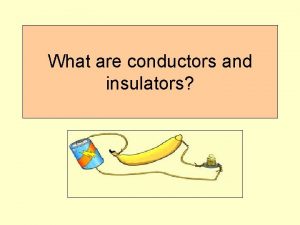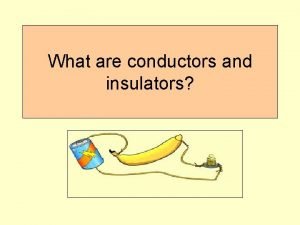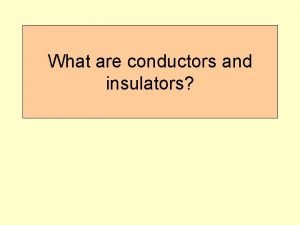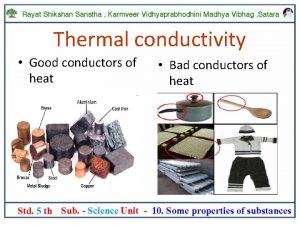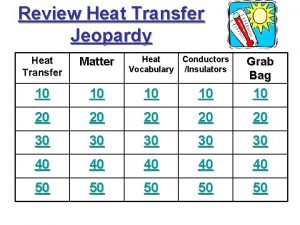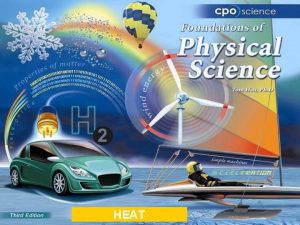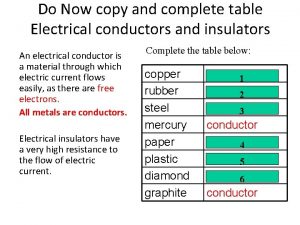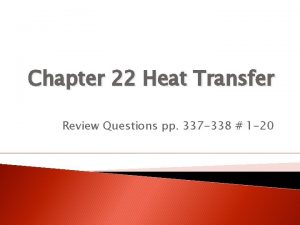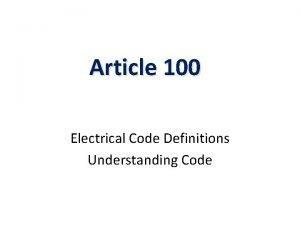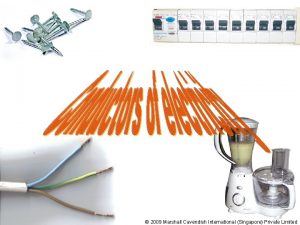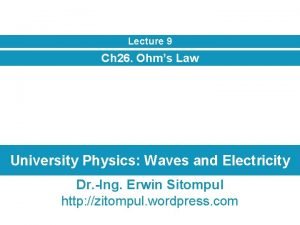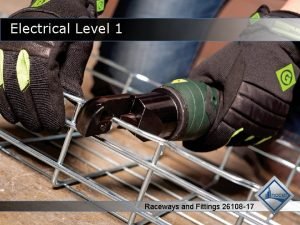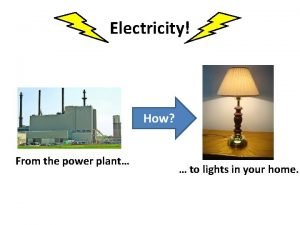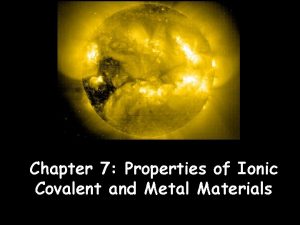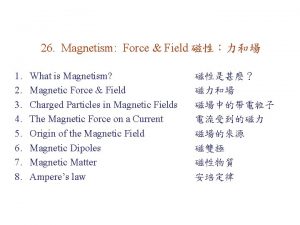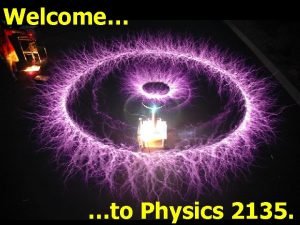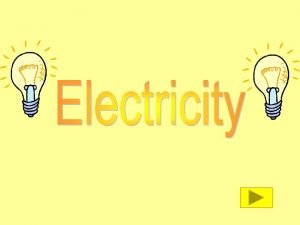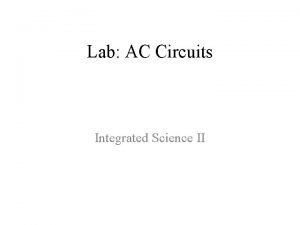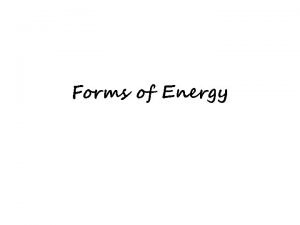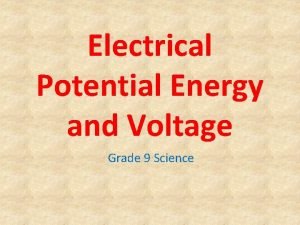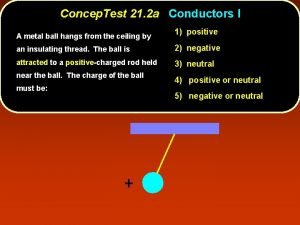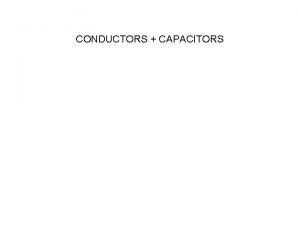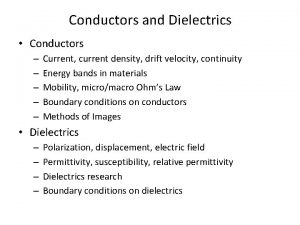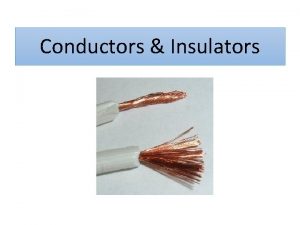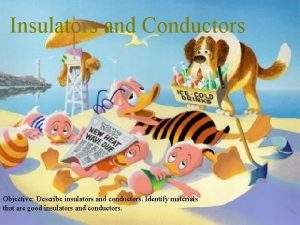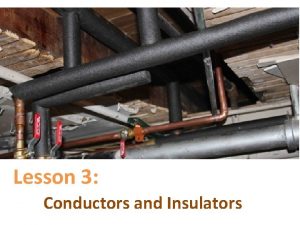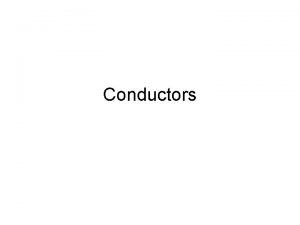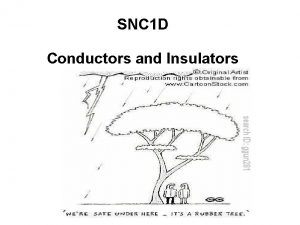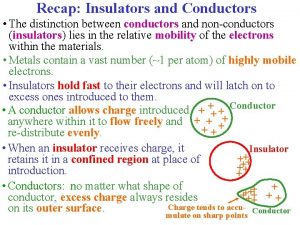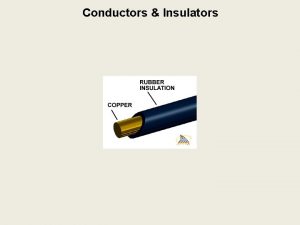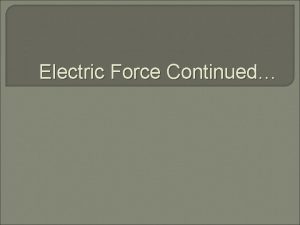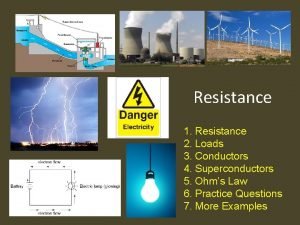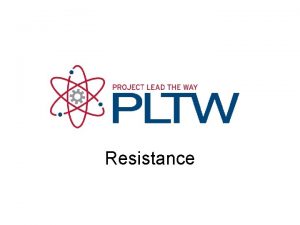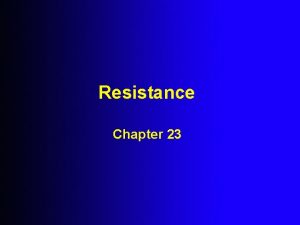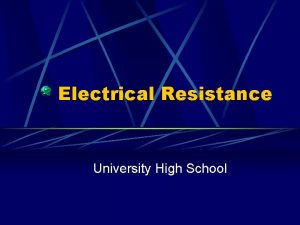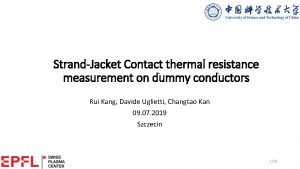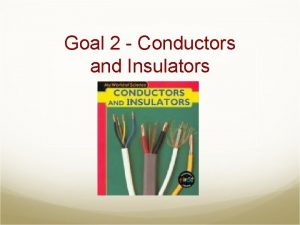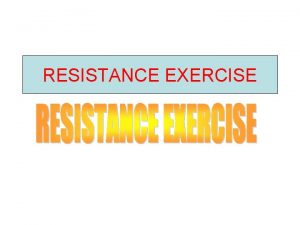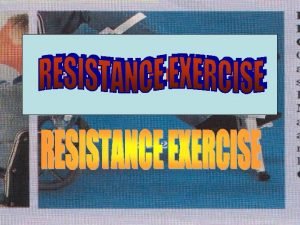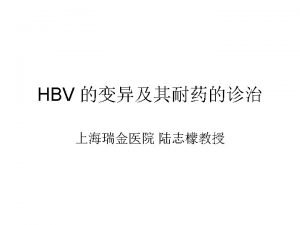Chapter 3 Resistance Resistance of Conductors Resistance of






























- Slides: 30

Chapter 3 Resistance

Resistance of Conductors • Resistance of material is dependent on several factors: – Type of Material – Length of the Conductor – Cross-sectional area – Temperature 2

Type of Material • Atomic differences of materials cause variations in how electron collisions affect resistance • Differences produce resistivity 3

Type of Material • Represented by the symbol – (Greek letter rho) • Units of – Ohms x meters (Ω∙m) or (circular mils x ohms)/feet (Ω∙CM/ft) 4

Length • Resistance of a conductor – Directly proportional to its length – If you double the length of the wire, the resistance will double • = length – In meters or feet 5

Area • Resistance of a conductor – Inversely proportional to cross-sectional area of the conductor • If cross-sectional area is doubled – Resistance will be one half as much 6

Area • A= – Cross-sectional area, in m 2 or circular mils (CM) 7

Resistance Formula • At a given temperature (usually 20 o C) • Formula can be used with both circular and rectangular conductors 8

Electrical Wire Tables • American Wire Gauge is primary system to denote wire diameters • The higher the AWG number, the smaller the diameter 9

Electrical Wire Tables • A given length of AWG 22 wire will have more resistance than the same length of AWG 14 wire • Larger gauge wires can handle more current 10

Circular Mils (CM) • Length may also be in mils (0. 001 inch) • Area may be in circular mils (CM) • 1 CM – Area of a circle having a diameter of 1 mil 11

Circular Mils (CM) • 1 square mil – Area of a square having sides of 1 mil • 1 CM = – /4 square mils 12

Temperature Effects • For most conductors, a temperature increase causes an increase in resistance • Increase is relatively linear • In semiconductors and insulators – Increase in temperature results in decrease in resistance 13

Temperature Effects • Any material for which the resistance increases with temperature is said to have a positive temperature coefficient • If it decreases, it has a negative coefficient 14

Temperature Effects • Temperature coefficient – Rate of change of resistance with respect to temperature • It is represented by (Greek letter alpha) 15

Temperature Effects • Resistance at a specific temperature (R) may be calculated from resistance at a different temperature (R 1) by the formula: 16

Temperature Effects • Where ΔT = – T 1 is the difference between the two temperatures in Celsius degrees 17

Fixed Resistors • Resistance of a fixed resistor is constant over a wide temperature range • Rated by amount of resistance – Measured in ohms (Ω) • Also rated by power – Measured in watts (W) 18

Fixed Resistors • Different resistors for different applications – Molded carbon composition – Carbon film – Metal Oxide – Wire-Wound – Integrated circuit packages 19

Variable Resistors • Resistance may be changed (varied) – Adjust volume, set level of lighting, adjust temperature • Have three terminals – Center terminal connected to wiper arm • Potentiometers • Rheostats 20

Color Code • Colored bands on a resistor provide a code for determining – Value – Tolerance – Reliability 21

Measuring Resistance • • • Ohmmeter Remove all power sources to circuit Isolate component Connect probes across component No need to worry about polarity Ohmmeter determines shorts and opens 22

Thermistors • Two-terminal transducer – Resistance changes with temperature • Applications include electronic thermometers and thermostatic control circuits for furnaces 23

Thermistors • Most have negative temperature coefficients 24

Photoconductive Cells • Two-terminal transducers – Resistance determined by amount of light • May be used to measure light intensity or to control lighting • Used in security systems • Linear response (negative slope) 25

Diodes • Semiconductor devices – Conduct in one direction only – In forward direction, has very little resistance – In reverse direction, resistance is very high • Open circuit 26

Varistors • Resistors sensitive to voltage • High resistance when voltage is below breakdown value • Low resistance when voltage is above breakdown value • High power ratings – When used in surge protectors 27

Conductance • Measure of a material’s ability to allow flow of electrical current • Conductance is reciprocal of resistance • G = 1/R • Unit is siemens (S) 28

Superconductors • Low temperatures – Resistance of some materials goes to almost zero • Temperature is called critical temperature 29

Superconductors • Meissner Effect – Cooled below its critical temperature – Magnetic fields may surround but not enter the superconductor 30
 Constant rate filtration
Constant rate filtration Friction and air resistance
Friction and air resistance What is conductor and insulator
What is conductor and insulator What are conducters
What are conducters What are conductors
What are conductors Insulators example
Insulators example Uses of bad conductors of heat
Uses of bad conductors of heat Jeopardy conductor
Jeopardy conductor Atomic structure of conductor
Atomic structure of conductor What are conductors and insulators
What are conductors and insulators Heat conductors
Heat conductors Slidetodoc.com
Slidetodoc.com 5,6,26,109,?
5,6,26,109,? Table of conductors and insulators
Table of conductors and insulators How does archimedes principle relate to convection
How does archimedes principle relate to convection A feeder consists of all circuit conductors located ____
A feeder consists of all circuit conductors located ____ Conductors examples
Conductors examples The figure below shows three cylindrical copper conductors
The figure below shows three cylindrical copper conductors A _____________ is a round raceway that houses conductors
A _____________ is a round raceway that houses conductors Insulators and conductors
Insulators and conductors Compound vs molecule
Compound vs molecule Force between parallel conductors
Force between parallel conductors Study jams conductors and insulators
Study jams conductors and insulators Are dielectrics conductors
Are dielectrics conductors Mst physics 2135
Mst physics 2135 Example of conductors
Example of conductors Integrated science lab experiments
Integrated science lab experiments Electrical energy
Electrical energy Non conductors of electricity
Non conductors of electricity Seat partner
Seat partner A metal ball hangs from the ceiling by an insulating thread
A metal ball hangs from the ceiling by an insulating thread



